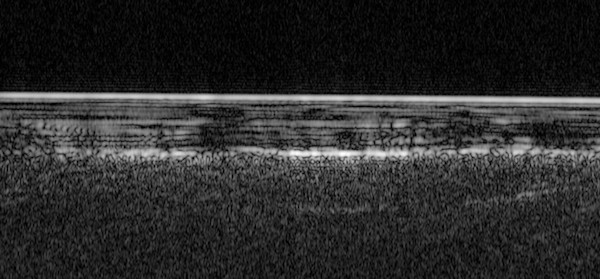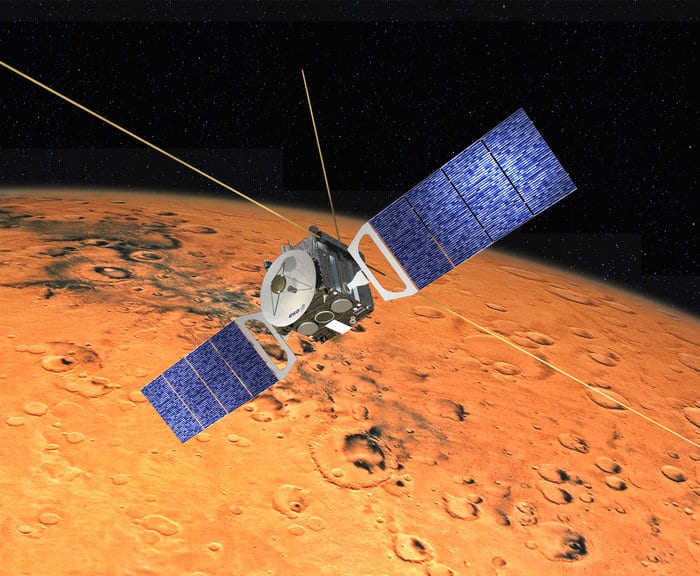For the first time, evidence of liquid water on Mars has been detected. Previous studies have suggested that liquid water might exist on the surface under certain conditions, but although Mars is scarred with remains of river valleys and channels where water once flowed, major changes in the planet’s climate mean that it cannot exist today in any persistent form.

The Mars Express orbiter, which has been studying Mars since 2003, carries a radar sounding instrument called MARSIS (Mars advanced radar for subsurface and ionosphere sounding), which uses ground-penetrating radar to map the subsurface topography of the planet. This technique, also widely used by engineers on Earth, sends radar pulses towards the surface and times how long it takes for them to be reflected back, and analyses the reduction in the strength of the returning signal. This gives clues on the composition of the material through which the radar pulse travelled before being reflected.

The new discovery was made during an investigation of the south polar region of Mars, which covered a 200km wide area. MARSIS data suggests that the region is composed of many alternating layers of solid ice and dust, in a structure somewhat similar to filo pastry. Of particular interest was a bright radar reflection underneath layered deposits within a 20km wide zone.
A bright reflection indicates that something below the surface is reflecting light more strongly than the surface itself, and to ground penetrating radar specialists that is strong evidence of the presence of water. The signal was coming from a depth of 1.5km below the surface, and originated from a deposit some tens of centimetres deep.
It has long been suspected that water existed below the ice on Mars, because it exists under similar conditions on Earth. The immense weight of a glacier increases the pressure at its base, and this depresses the melting point of water. Moreover, the presence of water-soluble salts on Mars has been proven, and these would also reduce the melting point, possibly even to below 0°C.
The Mars Express team is therefore interpreting the anomalous signal from MARSIS as a lake or pond of liquid water, which might be saturated with salts dissolved from sediments. In a paper in Science, the team explains how they had seen tantalising evidence of these features in the past but they proved inconclusive.
“We'd seen hints of interesting subsurface features for years but we couldn't reproduce the result from orbit to orbit, because the sampling rates and resolution of our data was previously too low," explained Andrea Cicchetti, MARSIS operations manager and a co-author on the new paper. "We had to come up with a new operating mode to bypass some onboard processing and trigger a higher sampling rate and thus improve the resolution of the footprint of our dataset: now we see things that simply were not possible before."
https://www.theengineer.co.uk/issues/november-2013-online/maven-nasas-martian-atmosphere-quest/
The MARSIS instrument was developed by the University of Rome partnership with NASA’s Jet Propulsion Laboratory in Pasadena; NASA co-funded the instrument with the Italian space agency.
The discovery could be particularly significant, because the subglacial lakes on Earth, such as Lake Vostock, 4km under the ice of Antarctica, contain microbial life. We now know that the surface of Mars, with its frigid temperatures and high solar radiation flux, cannot support any form of life that we know, so the search for living organisms is now confined to below the surface where overlying materials may provide some degree of protection.
Mannish Patel of the Open University explained to the BBC that the MARSIS discovery does not bring us closer to detecting life, but gives us an important clue about where to look. “This is just one small study area; it is an exciting prospect to think there could be more of these underground pockets of water elsewhere, yet to be discovered," said Roberto Orosei, principal investigator of the MARSIS experiment and lead author on the Science paper.




Nanogenerator consumes CO2 to generate electricity
Whoopee, they've solved how to keep a light on but not a lot else.